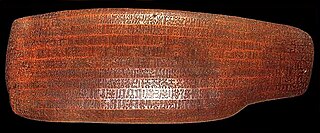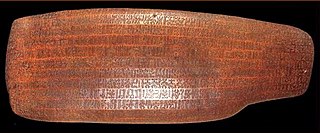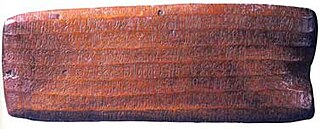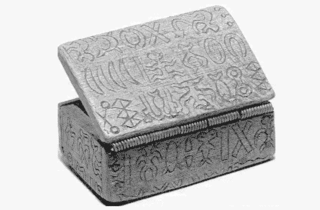
Text M of the rongorongo corpus, the larger of two tablets in Vienna and therefore also known as the Large or Great Vienna tablet, is one of two dozen surviving rongorongo texts.

Text M of the rongorongo corpus, the larger of two tablets in Vienna and therefore also known as the Large or Great Vienna tablet, is one of two dozen surviving rongorongo texts.
M is the standard designation, from Barthel (1958). Fischer (1997) refers to it as RR24.
Museum für Völkerkunde, Vienna. Catalog # 22869.
There is a reproduction in the Musée de l'Homme, Paris.
A rotted unfluted tablet of Pacific rosewood (Orliac 2005), 28.4 × 13.7 × 2.5 cm, M is one of the rongorongo tablets in the worst condition. It evidently lay on side b in damp soil, probably in a cave, for many years. The edges are rotted and the surfaces worm-eaten. Fischer suggests that the gashes on the top and side may have been intentional, for lashings.
In 1882 an archaeological expedition aboard the SMS Hyäne visited Easter Island, and captain Wilhelm Geiseler purchased two tablets. The purchase had been arranged by Schlubach, the German consul in Valparaíso, at the request of Adolf Bastian, the director of the Königliches Museum für Völkerkunde in Berlin. The tablets were given to the uncle of Schlubach's wife, Alexander Salmon, Jr, who then shipped three tablets, M, N, and O, to Schlubach. Several years later, when Schlubach returned to Hamburg, he sent just one of the tablets to Bastian and sold the other two privately to the Hamburg firm "Klée und Kocher". They were then sold to the Austrian Vice-Consul in Hamburg, Heinrich Freiherr von Westenholz, who donated them to Vienna's Museum für Völkerkunde in 1886.
Alexander Salmon, Jr, the manager of the Brander plantations on Easter Island who had transcribed and (poorly) translated the 'readings' that Jaussen obtained for his texts, encouraged the manufacture of Rapanui artworks, and several scholars have questioned its authenticity. However, he never presented them as authentic, and Fischer accepts this text as genuine.
Although there is little text to go on, Fischer reports that line Mr2 shares two sequences of glyphs with Gr2 of the Small Santiago tablet, which he suggests may have been the model for the Large Vienna.
| | This section needs expansion. You can help by adding to it. (June 2008) |
Nine lines of ~ 120 glyphs are visible on side a; side b is 'destroyed'. Fischer says that Mapparently once held c. 11 lines of text on either side, much like "Mamari". Line a7 has 'faint traces' of glyphs which Fischer believes might be recoverable with electronic imaging.
Fischer also reports (p. 398) that M has suffered recent damage:

Rongorongo is a system of glyphs discovered in the 19th century on Easter Island that has the appearance of writing or proto-writing. Numerous attempts at decipherment have been made, but none have been successful. Although some calendrical and what might prove to be genealogical information has been identified, none of the glyphs can actually be read. If rongorongo does prove to be writing and to be an independent invention, it would be one of very few inventions of writing in human history.

Rongorongo is a system of glyphs discovered in the 19th century on Easter Island that appears to be writing or proto-writing. Text B of the rongorongo corpus, also known as Aruku Kurenga, is one of two dozen surviving rongorongo texts.
Text C of the rongorongo corpus, also known as Mamari, is one of two dozen surviving rongorongo texts. It contains the Rapa Nui calendar.

Rongorongo is a system of glyphs discovered in the 19th century on Easter Island that appears to be writing or proto-writing. Text D of the rongorongo corpus, also known as Échancrée ("notched"), is one of two dozen surviving texts. This is the tablet that started Jaussen's collection.

Text G of the rongorongo corpus, the smaller of two tablets located in Santiago and therefore also known as the Small Santiago tablet, is one of two dozen surviving rongorongo texts. It may include a short genealogy.

Text H of the rongorongo corpus, the larger of two tablets located in Santiago and therefore also known as the Great or Large Santiago tablet, is one of two dozen surviving rongorongo texts, and one of three recording the so-called "Grand Tradition".

Text I of the rongorongo corpus, also known as the Santiago Staff, is the longest of the two dozen surviving rongorongo texts. Statistical analysis suggests that its contents are distinct from those of the other texts.
Text N of the rongorongo corpus, the smaller of two tablets in Vienna and therefore also known as the Small Vienna tablet, is one of two dozen surviving rongorongo texts. It repeats much of the verso of tablet E.
Text Q of the rongorongo corpus, the smaller of two tablets in St. Petersburg and therefore also known as the Small St Petersburg tablet, is one of two dozen surviving rongorongo texts, and one of three recording the so-called "Grand Tradition".
Text P of the rongorongo corpus, the larger of two tablets in St. Petersburg and therefore also known as the Great or Large St Petersburg tablet, is one of two dozen surviving rongorongo texts, and one of three recording the so-called "Grand Tradition".

Text R of the rongorongo corpus, the smaller of two tablets in Washington and therefore also known as the Small Washington tablet, is one of two dozen surviving rongorongo texts.

Text S of the rongorongo corpus, the larger of two tablets in Washington and therefore also known as the Great or Large Washington tablet, is one of two dozen surviving rongorongo texts.

Rongorongo is a system of glyphs discovered in the 19th century on Easter Island that appears to be writing or proto-writing. Text F of the rongorongo corpus, also known as the (Stephen) Chauvet tablet, is one of two dozen surviving texts.
Text K of the rongorongo corpus, also known as the (Small) London tablet, is one of two dozen surviving rongorongo texts. It nearly duplicates the recto of tablet G.

Text Y of the rongorongo corpus, known as the Paris Snuff Box, is one of two dozen surviving rongorongo texts.
Text T of the rongorongo corpus, also known as Honolulu tablet 1 or Honolulu 3629, is the only fluted tablet in the Honolulu collection and one of two dozen surviving rongorongo texts.
Text U of the rongorongo corpus, carved on a beam, also known as Honolulu tablet 2 or Honolulu 3628, is one of two dozen surviving rongorongo texts.
Text V of the rongorongo corpus, the Honolulu oar, also known as Honolulu tablet 3 or Honolulu 3622, may be one of two dozen surviving rongorongo texts. Its authenticity has been questioned.

Text L of the rongorongo corpus, also known as (London) reimiro 2, is the smaller of two inscribed reimiro in London and one of two dozen surviving rongorongo texts.
Text O of the rongorongo corpus, the Berlin tablet, is one of two dozen surviving rongorongo texts.